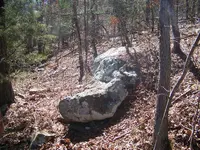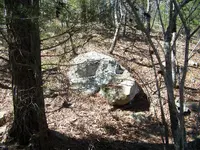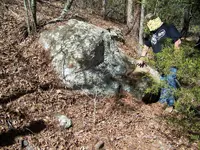I think you will like this rangler. It is a post by stilldign from 07
[TH="class: lastcol comment-header, colspan: 3"]Comment[/TH]
[TD="class: th firstcol poster-name"]
stilldign
[/TD]
[TD="class: th post-subject"]
More About the Duck Symbol
[/TD]
[TD="class: th post-number"]Lead[/TD]
[TD="class: th toggle lastcol"] [-] [/TD]
[TD="class: firstcol poster-detail"]

Mar 26 07
[/TD]
[TD="class: post-content lastcol, colspan: 3"]
Tags :
None
The duck symbol is a common symbol at treasure sites. It
is also a very complex symbol due to the many "applications" that can apply to it.
I have stated before that each treasure symbol has a specific meaning and, while this is somewhat true, the full truth is that a symbol, any symbol, can and will have multiple meanings. The meanings and interpretations of these symbols change as you get "deeper" into a treasure trail. For example, when starting out at the beginning of a treasure trail you can find a horseshoe, which in this case means to follow the direction of the shoe. However, once at the treasure site, the horseshoe, when found, means do turn around and go back and try again, that you have failed to properly interpret the signs and monuments.
The duck symbol, as I stated before, is an ideal symbol when you consider the actions of a duck. First and foremost, the duck symbol, when found at your treasure site, means that you are going to be "tricked". Ever notice how a duck can dive under water and then come reappear in a totally different location? This is what is going to happen at your treasure site. You will be following a triangle, for example, and, if your not careful enough to spot this duck symbol, then you not not be aware of where the true treasure trail has "ducked out" on you, leaving you scratching your head and going back to try to figure out where you went wrong in your calculations.
When at these duck sites, obviously you need to find out where the ducking out took place. You will be taken to another partially buried rock which willl have more signs taking you into another formation. DO NOT FALL FOR THIS FALSE INFORMATION. Your final measurement to the treasure room will be made from this rock.
Another reason that the duck is used is that the head of the duck, when found on the rock map that you will recover at your site, will turn into the clapper of a bell. In other words, when read the rock map in one postion the rock will look like a duck (a decoy), but as you "roll" the rock map into another position (which is typical) you will find that the duck nows becomes the bottom of a bell, and that the actual duck head now becomes the clapper of the bell. This is important becasue this bell now tells you how far to measure from when you locate your "ducking out" rock. Add up the letter value of the word bell....B equals 2, E equals 5, and each L equals 12, for a total of 31. This is how many feet you need to measure from the "ducked out" rock. Now all you need to know is the direction to measure. This info will also be found on your rock map.
You can also find the duck at alpha monuments. These are rather large ducks, but they aren't always a complete duck...so it's important to pay close attention to your alpha's. When found at the alpha, simply follow the ducks head or beak in the direction it is pointing or looking.
[TD="class: lastcol post-content, colspan: 3"]
[/TD]
[TD="class: th firstcol poster-name"]
stilldign
[/TD]
[TD="class: th post-subject"] The Duck[/TD]
[TD="class: th post-number"]
#3
[/TD]
[TD="class: th toggle lastcol"] [-][/TD]
[TD="class: firstcol poster-detail"]

Mar 27 07
[/TD]
[TD="class: lastcol post-content, colspan: 3"] I should mention that, at treasure locations that use the duck, as you dig at the specific sites that you are told to dig at you may run into a rock map shaped like a duck. This is simply telling you that you are on a false trail, that you were "ducked-out" on. Go back and start over.
[/TD]
Pinwheel
[/TD]








